
One of the many qualities that have made the United States of America what it is today is its adaptability. Throughout history, the country has navigated through numerous crises and uncertainties, coming out victorious at the other end. Such resilience is reflected in the social and financial spheres of the US. As the global economic landscape is likely to change with de-dollarization, the US remains resilient, adaptable, and ready to find fruitful opportunities as a global leader.
For the longest time, countries across the globe used the US dollar (USD) as their chief reserve currency. Irrespective of where you live, you must have seen the USD being used as a standard for conducting international trade and business. This has been the case since the Second World War, which led to the US’s emergence as a global superpower.
However, things are starting to change. Lately, countries have begun moving away from the US dollar for international trade and global finance purposes. Various global events are responsible for this trend, commonly known as de-dollarization. For example, sanctions on Russia following its conflict with Ukraine made countries like China and Russia find suitable alternatives to the US dollar.
Moreover, fearing asset freezes, countries have started increasing their gold reserves. Such changes have a significant impact on international trade, gold prices, and the global economy as a whole.
This blog dives into de-dollarization and explores its impact on gold and the global economy.

The US has been the world’s topmost reserve currency for several decades. The central banks of multiple countries held it to conduct international trade and store value.
The International Monetary Fund states that by the first quarter of 2023, the US dollar made up 59% of all allocated currency reserves around the world. The Euro followed with under 20%, followed by the Japanese Yen at almost 5%.
However, such a high share of the US dollar in the global economy has started decreasing as countries have started seeking alternatives to the same. This reduction in countries’ reliance on USD is known as de-dollarization.
Instead of holding reserves in dollars, countries' central banks have the option to hold reserves in gold or a different currency. Additionally, nations can enter into arrangements that discourage using the dollar when settling transactions across borders.
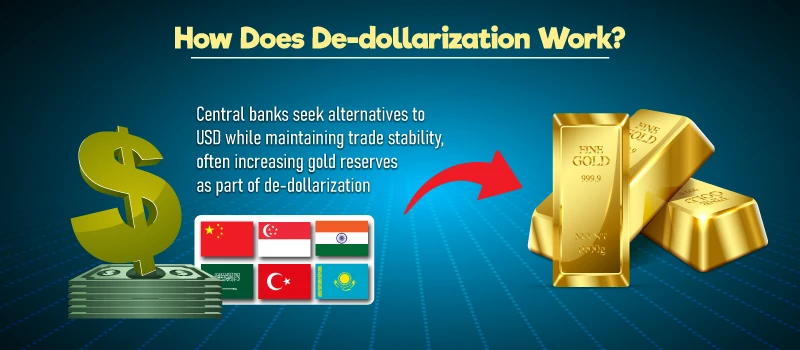
The approach to de-dollarization differs for different countries. Basically, the central bank of a country finds the best alternative to USD without hampering international trade, while upholding its local financial system.
Traditionally, the euro, yen, and British pound sterling have been the best alternatives to the US dollar. However, these currencies have not increased their respective shares even after the decline of USD.
China seems to be the prime driver of de-dollarization as it aims to position its renminbi as an alternative. While central banks worldwide have increased their renminbi holdings, the currency's global share remains below 2.5%. Interestingly, Russia holds one-third of all Chinese currency reserves in the world, further influencing the decline of USD in global trade.
Apart from looking for an alternative, countries participate in de-dollarization by holding their reserves in gold. The World Gold Council states that the central bank demand for gold shot up to 1,136 metric tons, with a 152% jump in a single year!
The specific reason for de-dollarization depends on the country in question. Having said that, here are three of the most common reasons why countries are moving away from the US dollar:

The US has issued the world’s reserve currency for many decades. When the majority of countries use USD for international trade and global finance, a single country’s influence over the world economy increases.
This puts the US at an economic advantage over other countries. Even if the dollar falls sharply, it will not push the country into the crisis. Its central bank can simply issue more money to deal with the problem. On the other hand, other countries continue tailing the US’s monetary and economic policies. Such a scenario has made many countries move away from USD.
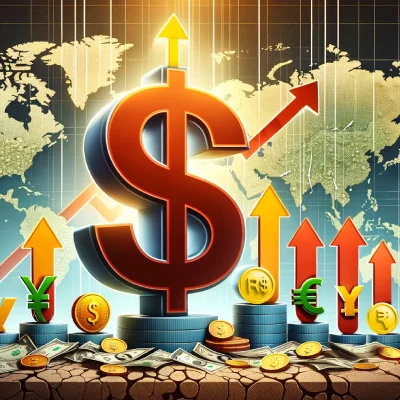
As the US continues to influence international trade with its reserve currency, its value keeps increasing against the currencies issued by developing economies. This makes imports more expensive for these emerging nations.
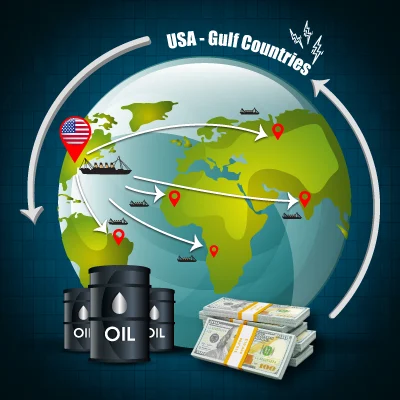
One of the biggest reasons behind the US dollar gained influence in international trade is the Gulf countries trading oil using USD. An official arrangement made in 1945 declared that Saudi Arabia would sell oil to the US using USD. In return, Saudi would reinvest the dollars in various US companies and treasuries.
However, things started to change when the US became energy-independent and a net oil exporter. As its reliance on the Gulf countries for oil reduced, the exporters started re-orienting themselves to other currencies for oil trade.
Apart from the oil trade changes, the tumultuous relationship between the US and the Gulf countries (especially Saudi Arabia) has also made the oil-exporting countries seek alternatives to the US dollar.
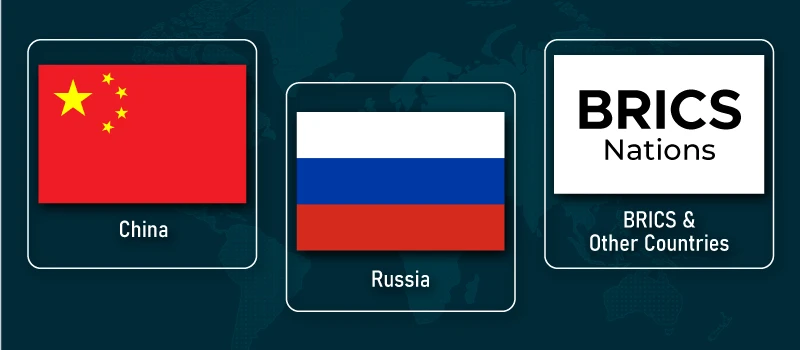
Let us now have a look at the key players involved in the de-dollarization movement:
China has been a front-runner in the de-dollarization movement for several years. Seeking economic independence and global power, the country has been issuing reserve currency for quite some time. In fact, Russia is the biggest holder of the renminbi as a reserve currency, adding to the ongoing de-dollarization movement.
Russia’s conflict with Ukraine has imposed several restrictions on the country, leaving it no choice but to move away from the US dollar. Since seven Russian banks were excluded from the SWIFT (Society for Worldwide Interbank Financial Telecommunication) banking system, the country has resorted to alternative currencies for international trade.
The increasing influence of the US over global economic affairs has prompted the BRICS nations (originally Brazil, Russia, India, China, and South Africa) to move away from the US dollar. The bloc has now expanded to include countries like Egypt, Saudi Arabia, UAE, Iran, and Ethiopia. These countries aim to trade with each other using their own respective currencies to create a multipolar financial world.
From the economics of individual countries to international trade competitiveness, let us have a look at the impact of de-dollarization on the global economy:
If a country moves to other currencies by reducing its dollar holdings, the dollar’s demand will decrease. This will depreciate USD against other currencies, leading to exchange rate fluctuations. This may be good news for emerging countries for whom the US dollar was always expensive.
Over time, de-dollarization will impact international trade by increasing currency conversion costs for both exporters and importers. De-dollarization will make countries transact in different currencies, increasing the need to hedge against unfavorable exchange rate fluctuations. This will increase transaction costs, potentially hampering trade efficiency for businesses conducting cross-border business.
De-dollarization will increase a country’s autonomy over monetary policies. It will allow central banks to adjust money supply and interest rates to adapt effectively to domestic economic conditions.
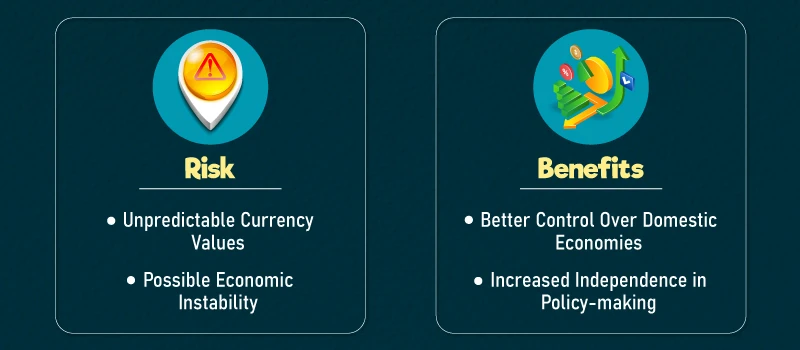
De-dollarization carries shades of gray. It is difficult to categorize it as a wholly beneficial or risky occurrence.
To make matters clearer, let us have a look at a couple of risks and benefits of de-dollarization:
Without a stable currency reserve, the currency values across countries will become increasingly unpredictable. This will make international (and domestic) trade risky for multiple countries that once honton to the US dollar.
Without a stable currency reserve, the currency values across countries will become increasingly unpredictable. This will make international (and domestic) trade risky for multiple countries that once honton to the US dollar.
The influential US reserve currency made many investors use it as a profitable investment vehicle. With countries finding an alternative to USD, investment decisions will change.
Here are a few ways in which de-dollarization affects investors:
With the dollar’s influence reducing on international trade, you can see investors shifting to gold and other currencies for safe and fruitful investments.
A major downside of de-dollarization is that investors will now operate in a volatile global market. The lack of a dominant currency reserve will lead to increased market fluctuations every investor should navigate.
Thriving in a fluctuating market calls for better risk management. We are likely to see investors gear up with comprehensive risk management strategies to make safer investments that give good returns in a global market devoid of the US dollar’s dominance.
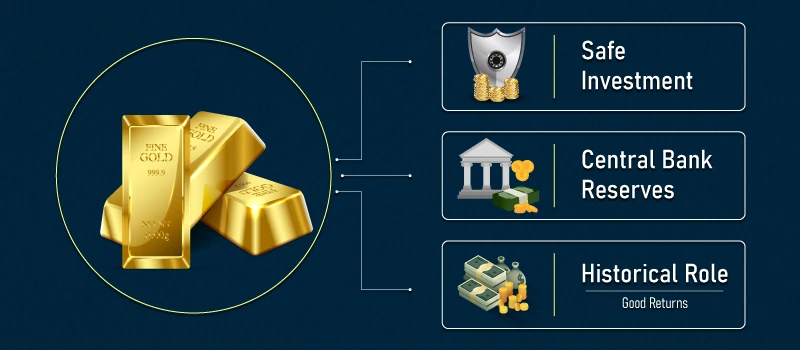
Arguably, the biggest reward for de-dollarization is gold investors. In the wake of a likely economic shift, there has never been a better time to invest in gold.
Allow the Wall Street Journal to elaborate:
Let us have a look at a few ways in which gold plays an important role in de-dollarization:
As countries move away from the US dollar, so do investors. Under such a scenario, gold investment is considered to be one of the safest investment decisions for people across the globe.
Along with investors, central banks of countries have started buying more gold to create a cushion against unpredictable currency changes. This further increases the value of gold for investors.
Here is what Bloomberg Television has to say about central banks buying gold:
History has proven that gold has always emerged as a safe investment during times of economic instability. Keeping this in mind, you can rest assured that gold investment will only skyrocket in the wake of de-dollarization, giving handsome returns to investors in the long run.
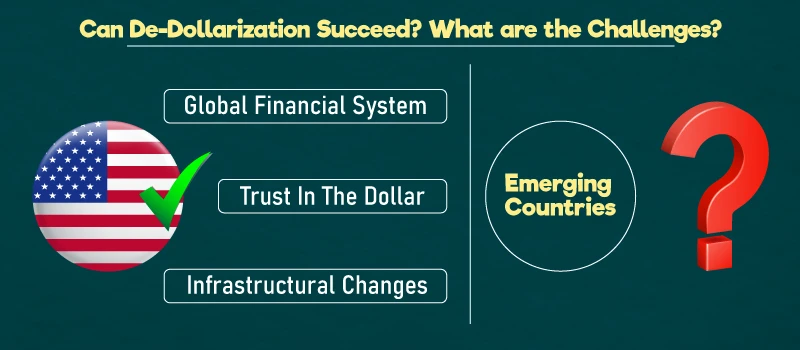
While the benefits of de-dollarization look appealing on paper, its practical implications may not be so seamless. The shift is not that simple and countries will face several challenges to move away from the US dollar.
Here are a few major challenges that stand in the way of successful de-dollarization:
Over several decades, the US dollar has occupied a specific place and enjoys prestige in the global financial system. It has embedded itself in this system in a way that moving away from it will not be an easy task. This is bound to make the shift of de-dollarization difficult for many countries.
Not all countries are as stable as China and Russia when it comes to handling de-dollarization well. The infrastructure needed to shift to a new reserve currency and handle international finance in a new way is a big challenge for several countries.
Say what you may, you cannot discount the trust the US dollar has enjoyed for decades. The stability in international trade and finance so far will make it difficult for countries to trust a new alternative and move away from the USD.
The world after de-dollarization can be tricky to imagine. Amidst increasing uncertainties, here is what Prof Wolff has to say about the future after de-dollarization:
Irrespective of the speculations, one thing is clear: de-dollarization will only increase the value of gold investments. Do follow the geopolitical development and global economic policies to understand where de-dollarization is headed.
In the meantime, if you wish to make a safe and fruitful gold investment, check out BOLD Precious Metals to buy gold bars and coins at the lowest prices. We keep all our valued customers informed about economic and geopolitical affairs, helping you make seamless gold purchases.
With quick checkouts and personalized support, BOLD Precious Metals ensures that you stay unfazed in the midst of global economic uncertainties!